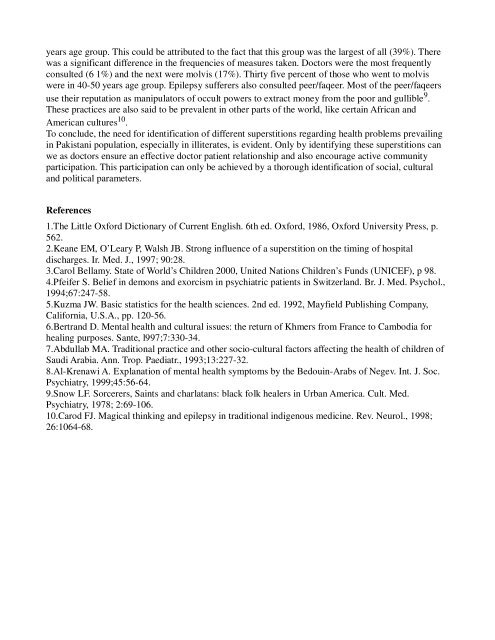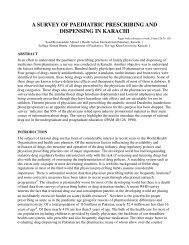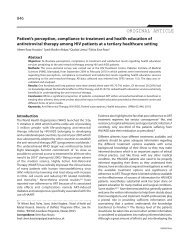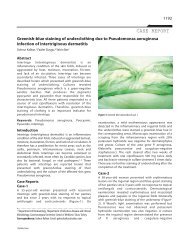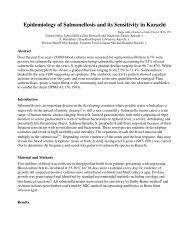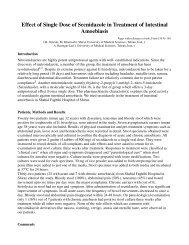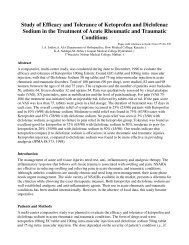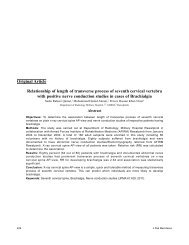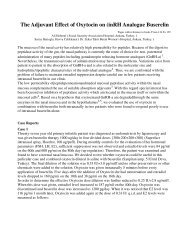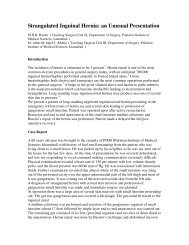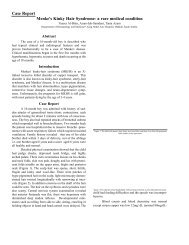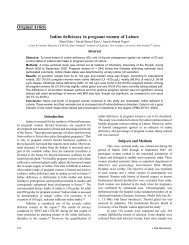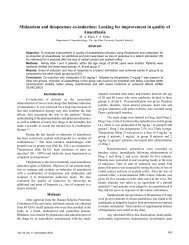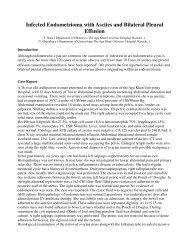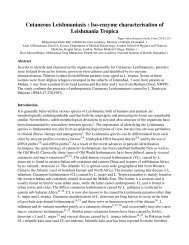Superstitions regarding Health Problems in different Ethnic Groups ...
Superstitions regarding Health Problems in different Ethnic Groups ...
Superstitions regarding Health Problems in different Ethnic Groups ...
You also want an ePaper? Increase the reach of your titles
YUMPU automatically turns print PDFs into web optimized ePapers that Google loves.
years age group. This could be attributed to the fact that this group was the largest of all (39%). There<br />
was a significant difference <strong>in</strong> the frequencies of measures taken. Doctors were the most frequently<br />
consulted (6 1%) and the next were molvis (17%). Thirty five percent of those who went to molvis<br />
were <strong>in</strong> 40-50 years age group. Epilepsy sufferers also consulted peer/faqeer. Most of the peer/faqeers<br />
use their reputation as manipulators of occult powers to extract money from the poor and gullible 9 .<br />
These practices are also said to be prevalent <strong>in</strong> other parts of the world, like certa<strong>in</strong> African and<br />
American cultures 10 .<br />
To conclude, the need for identification of <strong>different</strong> superstitions <strong>regard<strong>in</strong>g</strong> health problems prevail<strong>in</strong>g<br />
<strong>in</strong> Pakistani population, especially <strong>in</strong> illiterates, is evident. Only by identify<strong>in</strong>g these superstitions can<br />
we as doctors ensure an effective doctor patient relationship and also encourage active community<br />
participation. This participation can only be achieved by a thorough identification of social, cultural<br />
and political parameters.<br />
References<br />
1.The Little Oxford Dictionary of Current English. 6th ed. Oxford, 1986, Oxford University Press, p.<br />
562.<br />
2.Keane EM, O’Leary P, Walsh JB. Strong <strong>in</strong>fluence of a superstition on the tim<strong>in</strong>g of hospital<br />
discharges. Ir. Med. J., 1997; 90:28.<br />
3.Carol Bellamy. State of World’s Children 2000, United Nations Children’s Funds (UNICEF), p 98.<br />
4.Pfeifer S. Belief <strong>in</strong> demons and exorcism <strong>in</strong> psychiatric patients <strong>in</strong> Switzerland. Br. J. Med. Psychol.,<br />
1994;67:247-58.<br />
5.Kuzma JW. Basic statistics for the health sciences. 2nd ed. 1992, Mayfield Publish<strong>in</strong>g Company,<br />
California, U.S.A., pp. 120-56.<br />
6.Bertrand D. Mental health and cultural issues: the return of Khmers from France to Cambodia for<br />
heal<strong>in</strong>g purposes. Sante, l997;7:330-34.<br />
7.Abdullab MA. Traditional practice and other socio-cultural factors affect<strong>in</strong>g the health of children of<br />
Saudi Arabia. Ann. Trop. Paediatr., 1993;13:227-32.<br />
8.Al-Krenawi A. Explanation of mental health symptoms by the Bedou<strong>in</strong>-Arabs of Negev. Int. J. Soc.<br />
Psychiatry, 1999;45:56-64.<br />
9.Snow LF. Sorcerers, Sa<strong>in</strong>ts and charlatans: black folk healers <strong>in</strong> Urban America. Cult. Med.<br />
Psychiatry, 1978; 2:69-106.<br />
10.Carod FJ. Magical th<strong>in</strong>k<strong>in</strong>g and epilepsy <strong>in</strong> traditional <strong>in</strong>digenous medic<strong>in</strong>e. Rev. Neurol., 1998;<br />
26:1064-68.


